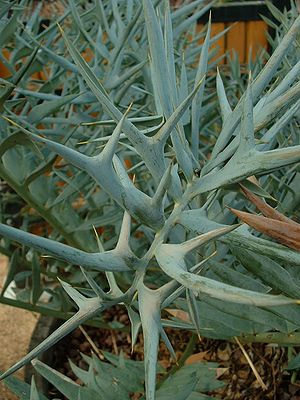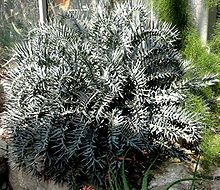Encephalartos horridus
| Encephalartos horridus | ||||||||||||
|---|---|---|---|---|---|---|---|---|---|---|---|---|

Encephalartos horridus |
||||||||||||
| Systematics | ||||||||||||
|
||||||||||||
| Scientific name | ||||||||||||
| Encephalartos horridus | ||||||||||||
| ( Jacq. ) Clay. |
Encephalartos horridus is a member of the cycads (Cycadales) and belongs to the genus of bread palm ferns ( Encephalartos ).
features

The trunks usually grow underground, are unbranched, but form many offshoots at the base, so that large trunk groups arise. The trunk rarely grows above ground and is up to 1.5 meters high with a diameter of 20 to 30 cm. The crown is always sparsely haired with wool. The numerous leaves are erect, stiff, 0.5 to 1 m long, 10 to 15 cm wide and curved sharply back and down. Young leaves are silvery blue; the color is caused by a layer of wax that weathers over time, leaving old leaves dull green. The petiole is 12 to 15 cm long and has a broadened, light brown base. The lower leaflets are increasingly reduced towards the base; the lowest consist only of a thorn . The middle leaflets are 10 to 13 cm long and 2.5 to 30 mm wide; each leaflet consists of two to three distinct lobes that are twisted out of the plane of the leaf. The leaf margins are strongly bent back. The tips of the leaflets and the leaf margin are covered with stiff, sharp thorns.
The female cones are single or up to three, in very old specimens up to five. They are egg-shaped, 25 to 50 cm long and 20 to 40 cm in diameter. The color ranges from (rarely) yellow to orange to bright red. The stem is very short so that the cone appears seated. The middle sporophylls are 5 to 6 cm long. The side of the sporophyll lying on the cone surface is 3 to 3.5 cm high, 4 to 4.5 cm wide and has a rough, pocky surface. The sarcotesta of the seed is pale red to crimson at maturity. The sclerotesta is ovate, 25 to 28 mm long, 15 to 18 mm in diameter, sometimes triangular in cross section, with a smooth, light brown surface.
The male cones are solitary, rarely in pairs. They are approximately cylindrical and 20 to 40 cm long with a diameter of 6 to 12 cm. The basic color is blue-green with black to red-brown thick hairs. The stem is 40 to 45 mm long with a diameter of 21 to 26 mm; it is colored and hairy like the cone. The sporophylls are 3.5 to 4 cm long. The side of the sporophyll lying on the cone surface is 15 to 18 mm high and 35 to 40 mm wide and ends in a one cm long beak. The surface is brown to black and red. The sporangia stand in a single spot.
The species is very variable, especially with regard to the leaves.
Distribution and locations
The species is native to South Africa; its occurrences are in the Eastern Cape Province in the districts of Port Elizabeth and Uitenhage . It grows in the Karoo bush, also in the Addo and Uitenhage bush in dry, desert-like areas together with succulent euphorbias and Strelitzia juncea . The precipitation is 250 to 600 mm, evenly distributed over the year. The climate is temperate with rare frosts in winter and summer temperatures of up to 40 ° C.
ecology
The species reproduces slowly in its natural habitat. One of the reasons is the weevil Antliarhinus zamiae , whose larvae eat the endosperm of the seeds. In the interplay with habitat loss, illegal collection and consumption by goats and porcupines, the species is endangered today.
Systematics
The species was first described in 1809 by Nikolaus Joseph von Jacquin as Zamia horrida . In 1834 Johann Georg Christian Lehmann introduced the species as Encephalartos horridus to the genus Encephalartos .
use
Due to the showy leaves and the simplicity of keeping, the species is often cultivated as an ornamental plant. Illegal trade in wild collection is a major threat to populations.
supporting documents
- Loran M. Whitelock: The Cycads. Timber Press, Portland OR 2002, ISBN 0-88192-522-5 , pp. 201 f.
Individual evidence
- ↑ Fragmenta botanica, figuris coloratis illustrata . 1809, p. 27. ( online )
- ↑ Novarum et Minus Cognitarum Stirpium Pugillus . Volume 6, 1834, p. 14. ( online )
Web links
- Encephalartos horridus on the Cycad Pages of the Royal Botanic Gardens Sydney.
- Encephalartos horridus inthe IUCN 2013 Red List of Threatened Species . Listed by: Donaldson, JS, 2009. Retrieved April 28, 2014.